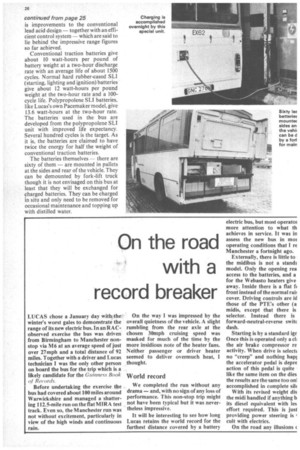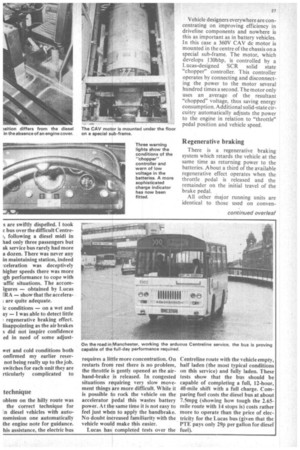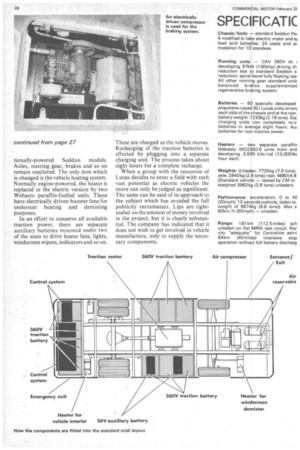On the road with a record breaker
Page 28

Page 29

Page 30

If you've noticed an error in this article please click here to report it so we can fix it.
LUCAS chose a January day with the winter's worst gales to demonstrate the range of its new electric bus. In an RACobserved exercise the bus was driven from Birmingham to Manchester nonstop via M6 at an average speed of just over 27mph and a total distance of 92 miles. Together with a driver and Lucas technician I was the only other person on board the bus for the trip which is a likely candidate for the Guinne,o, Book e)/ R ecordv.
Before undertaking the exercise the bus had covered about 100 miles around Warwickshire and managed a shattering 112.5-mile run on the flat MIRA test track. Even so, the Manchester run was not without excitement, particularly in view of the high winds and continuous rain. On the way I was impressed by the overall quietness of the vehicle. A slight rumbling from the rear axle at the chosen 30mph cruising speed was masked for much of the time by the more insidious note of the heater fans. Neither passenger or driver heater seemed to deliver overmuch heat, 1 thought.
World record
We completed the run without any drama — and, with no sign of any loss of performance. This non-stop trip might not have been typical but it was nevertheless impressive.
It will be interesting to see how long Lucas retains the world record for the furthest distance covered by a battery electric bus, but most operatoi more attention to what th achieves in service. It was in assess the new bus in mm Operating conditions that I re Manchester a fortnight ago.
Externally, there is little to the midibus is not a stanch model. Only the opening rea access to the batteries, and a for the Webasto heaters give away. Inside there is a flat Ii front instead of the normal rail cover. Driving controls are id those of the PTE's other (a midis, except that there is selector. Instead there is forward-neutral-reverse switc dash.
Starting is by a standard igr Once this is operated only a el: the air brake compressor re activity. When drive is select( no "creep" and nothing hapi the accelerator pedal is depre action of this pedal is quite like the same item on the dies the results are the same too onl accomplished in complete sib With its revised weight dis the midi handled if anything b its diesel equivalent with les effort required. This is just providing power steering is cult with electrics.
On the road any illusions Vehicle designers everywhere are concentrating on improving efficiency in driveline components and nowhere is this as important as in battery vehicles. In this case a 360V CAV dc motor is mounted in the centre of the chassis on a special sub-frame. The motor, which develops 130bhp, is controlled by a Lucas-designed SCR solid state "chopper" controller. This controller operates by connecting and disconnecting the power to the motor several hundred times a second. The motor only uses an average of the resultant "chopped" voltage, thus saving energy consumption. Additional solid-state circuitry automatically adjusts the power to the engine in relation to "throttle" pedal position and vehicle speed.
R egenerative braking
There is a regenerative braking system which retards the vehicle at the same time as returning power to the batteries. About a third of the available regenerative effect operates when the throttle pedal is released and the remainder on the initial travel of the brake pedal.
All other Major running units are identical to those used on conven s are swiftly dispelled. I took c bus over the difficult Centre', following a diesel midi in had only three passengers but ak service bus rarely had more a dozen. There was never any in maintaining station, indeed .ceteration was deceptively higher speeds there was more igh performance to cope with .affic situations. The accomigures — obtained by Lucas IRA — show that the accelera; are quite adequate.
ic conditions -on a wet and ay — I was able to detect little regenerative braking effect. lisappointing as the air brakes s did not inspire confidence ed in need of some adjust wet and cold conditions both onfirmed my earlier resernot being really up to the job. switches for each unit they are rticularly complicated to
technique
oblem on the hilly route was the correct technique for In diesel vehicles with autonsmission one automatically the engine note for guidance. his assistance, the electric bus requires a little more concentration. On restarts from rest there is no problem, the throttle is gently opened as the airhand-brake is released. In congested situations requiring very slow movement things are more difficult. While it is possible to rock the vehicle on the accelerator pedal this wastes battery power. At the same time it is not easy to feel just when to apply the handbrake. No doubt increased familiarity with the• vehicle would make this easier.
Lucas has completed tests over the Centreline route with the vehicle empty, half laden (the most typical conditions on this service) and fully laden. These tests show that the bus should be capable of completing a full, 12-hour, 40-mile shift with a full charge. Comparing fuel costs the diesel bus at about 7.5mpg (showing how tough the 2.65mile route with 14 stops is) costs rather more to operate than the price of electricity for the Lucas bus (given that the PTE pays only 29p per gallon for diesel fuel). tionally-powered Seddon models. Axles, steering gear, brakes and so on remain unaltered. The only item which is changed is the vehicle heating system. Normally engine-powered, the heater is replaced in the electric version by two Webasto paraffin-fuelled units. These have electrically driven booster fans for underseat heating and demisting purposes.
In an effort to conserve all available traction power, there are separate auxiliary batteries mounted under two of the seats to drive heater fans, lights, windscreen wipers, indicators and so on. These are charged as the vehicle moves. Recharging of the traction batteries is effected by plugging into a separate charging unit. The process takes about eight hours for a complete recharge.
When a group with the resources of Lucas decides to enter a field with such vast potential as electric vehicles the move can only be judged as significant. The same can be said of its approach to the subject which has avoided the full publicity razzamatazz. Lips are tightsealed on the amount of money involved in the project, but it is clearly substantial. The company has indicated that it does not wish to get involved in vehicle manufacture, only to supply the necessary components.




























































































